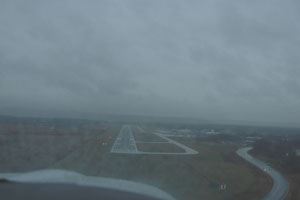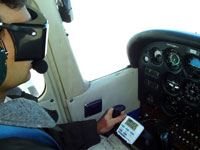- Home
- Flight Training
- Instrument Rating
 What is an instrument rating?
What is an instrument rating?
The instrument rating adds the greatest freedom and utility to the experience of flight. No longer limited to only clear or sunny days, an instrument-rated pilot uses gyroscopic instruments to navigate in and through the clouds and other obscuration while the VFR pilot waits on the ground for the weather to improve. Instrument flight often permits the timely completion of trips that might otherwise have been cancelled due to weather. Obtaining this rating adds safety, flexibility, and confidence to your flying.
Your instrument ground school instruction covers the charts, procedures, and rules necessary to become a safe and confident instrument pilot. Other subjects such as meteorology add to what you learned in your private pilot training. Another benefit of instrument training is the greater precision gained from accurate aircraft control and the use of the entire air traffic control system. For pilots with professional aspirations, this rating is the next step after private certification.
What are the requirements?
 Federal Aviation Regulations (FARs) require 40 hours of flight by reference to instruments for pilots training under Part 61, or 35 hours under Part 141. Pilots training under Part 61 are also required to log 50 hours of cross-country PIC time before completing the instrument rating. Due to the comprehensive, higher-quality training under Part 141, a pilot need not log these 50 cross-country hours. Therefore, training at a Part 141 school such as East Hill saves $4,000 to $6,000 in training costs. East Hill has a Precision Flight Controls 135 flight training device (commonly referred to as a "simulator") to make your training more flexible and less expensive. This highly versatile unit is great for training or currency when the ice and thunderstorms make flight inadvisable. The "freeze" and "playback" functions are wonderful tools to analyze those confusing hold entries. This device has full FAA approval for all courses.
Federal Aviation Regulations (FARs) require 40 hours of flight by reference to instruments for pilots training under Part 61, or 35 hours under Part 141. Pilots training under Part 61 are also required to log 50 hours of cross-country PIC time before completing the instrument rating. Due to the comprehensive, higher-quality training under Part 141, a pilot need not log these 50 cross-country hours. Therefore, training at a Part 141 school such as East Hill saves $4,000 to $6,000 in training costs. East Hill has a Precision Flight Controls 135 flight training device (commonly referred to as a "simulator") to make your training more flexible and less expensive. This highly versatile unit is great for training or currency when the ice and thunderstorms make flight inadvisable. The "freeze" and "playback" functions are wonderful tools to analyze those confusing hold entries. This device has full FAA approval for all courses.
The real concern for any pilot considering instrument training should not be the minimum hours required, but the quality and thoroughness of the training. The comprehensive, integrated ground school provided by the Jeppesen Guided Flight system assures that you have studied and understood the concepts involved in the next flight lesson. Just as in private pilot training, the syllabus specifies the ground lesson that precedes each flight lesson. You will always know where you are in your training and what is coming next.
During your training, you will be tested with three ground quizzes, a final exam, and three expanded briefings before you complete the course. You will complete a knowledge test and fly a practical test to obtain this rating. You will be well prepared at East Hill before testing with a FAA pilot examiner. Flight training in the Finger Lakes also provides ample opportunity for flying in actual cloud conditions and developing the skills necessary to use your rating with confidence and safety after graduation.
Why should I train at East Hill for my instrument rating?
- Superior ground and flight training under FAA Part 141, using Jeppesen Guided Flight Discovery system, produces professionally trained pilots.
- Save $4,000 to $6,000 in training costs by not logging unnecessary cross-country time required under Part 61 flight training.
- All three of East Hill's Cessna 172 Skyhawks are identically equipped with modern avionics: IFR-approved Garmin GNS430W GPS with Garmin GMA340 audio panels.
- Ithaca's tower-controlled airport allows each flight to be filed IFR with ATC.
- Nearby Elmira, Binghamton, and Syracuse airports, all with radar service, provide a variety of approaches and ATC environments. Thus several full instrument approaches can be completed in a flight lesson.
- We train in a variety of actual instrument conditions with safe alternates nearby. Real cloud-flying experience is vital for building confidence and true IFR skills.
- Finally, we enjoy greater service and flexibility from ATC than would be normally be available in busier training environments.
What's involved, and how do I get started?

Contact us at East Hill and stop by to meet the instructors, check out the planes, and even fly an "observation flight" to see what clouds look like from the inside. Since the Skyhawk has four seats, you can ride along in back and get a feel for the training environment. We fly all year, in all four seasons, seven days a week.
Once you purchase the self-paced Jeppesen ground school materials and enroll in the Part 141 program, you are ready to start flight training! Check out our rates and charges, and estimates for each rating. This is money well spent for your future safety and comfort as an instrument pilot.
Our graduates fly professionally for charter companies and airlines all over the country. Choose professional training to get professional results!
